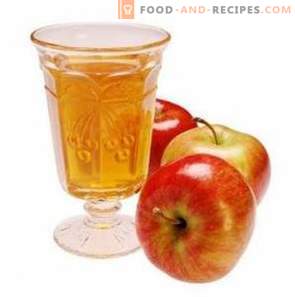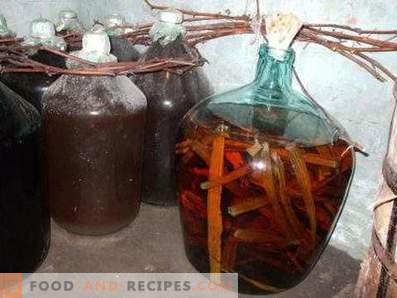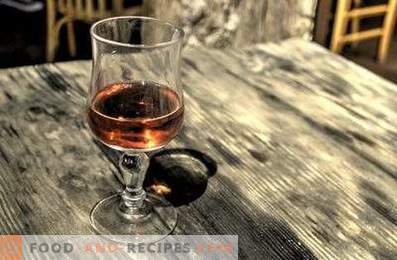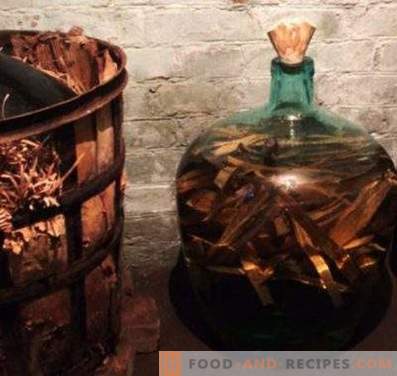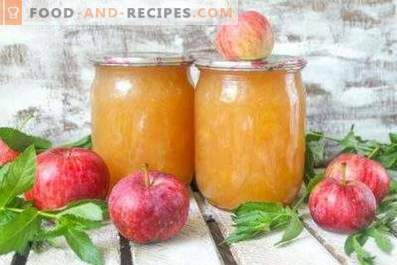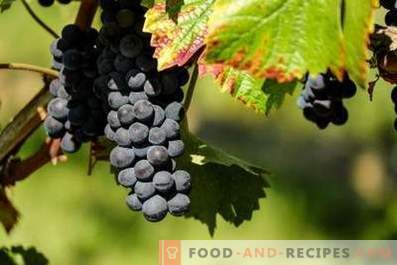
The original Calvados has been made in only one of the regions of France, in Normandy, for more than four centuries. This is distilled cider, infused in oak barrels. For a long time, he was considered a drink of the poor, but with a light feather Remarque became popular among representatives of various classes. The secret of its preparation is in the choice of certain varieties of apples grown specifically for this type of strong drink. It is believed that the drink made from other varieties of apples, calvados is not, winemakers call it already apple brandy. In fact, Calvados is also an apple brandy, but with a brand name. If you do not chase the accuracy of the wording, it should be recognized that Calvados can be done at home by everyone, and how exactly to call it is a minor issue.
Technology Features
Making apple brandy at home is a task that everybody can manage, but not easy. You should be patient, because this process is long, and also to study the subtleties of technology, so that the finished drink most closely resembles a real Calvados.
- The quality of the finished raw material will certainly affect the quality of the finished calvados. You should not take rotten apples, hoping that the process of distillation is ahead. In the best case, a drink from the spoiled fruit will have unpleasant notes, at worst, at the first stage, the raw material will not ferment, but will rot.
- Such varieties of apples, which are used in the production of the original Calvados, are not found in Russian gardens. Get the right bouquet will help a successful combination of different varieties of apples, which must be late varieties. The best combination is the following: 7 parts of bitter-sweet apples, 2 parts of sour fruits and 1 part of bitter (tart).
- In some recipes that can be found on the Internet, advice is given to washing and peeling apples from seed for making Calvados cider, using pure apple juice without pulp for this purpose. If you follow these recommendations, you will not get Calvados at home. First, it is impossible to wash the apples so that live bacteria that provide fermentation are preserved on them. The maximum that can be done with the fruits is to wipe them with a dry cloth to remove dust. Secondly, apple seeds help to give the future drink the desired flavor, so you should chop the fruit along with the core and peel.
- It is possible to collect apples for the preparation of alcoholic beverages, including calvados, only in dry weather, at least a couple of days after the last rain. Otherwise, the yeast on the surface of the fruit may be too little for full fermentation.
- One of the stages of Calvados cooking is the distillation of apple cider. In this case, the quality of the moonshine and the conditions of distillation matter. So, one should not allow the drink to heat above 85 degrees, and one should also stop the distillation when the fortress of the resulting brandy descends to 30 degrees. You should not expose the drink to double distillation, since in this case it will completely lose the aromatic notes characteristic of Calvados. The first and last portions of the liquid obtained by distillation (10% each) may contain toxic substances, so they will have to be spilled out.
- An important requirement in the preparation of Calvados, both in industrial and domestic environments, is to insist it in oak barrels for a long time. If you get this did not work, you can improve the drink as follows:
- Adjust the oak blocks to make chips in the form of chips, while avoiding getting into the chips of oak bark, which will give the drink a bitter taste.
- Pour oak “chips” on the bottom of glass jars.
- Pour Calvados into cans.
- Roll cans with metal lids, like compote, and leave for 8-12 months.
- Open the cans, filter the drink and pour it into glass bottles. Cork them, preferably with oak plugs.
If you prepare Calvados according to the classical technology, then you will try it no sooner than in a year. If you want to simplify and speed up the process, you can make a drink that imitates Calvados, but in fact is an apple tincture.
Classic homemade calvados recipe
Composition (for 1, 5-1, 6 l calvados):
- apples of bitter-sweet varieties - 14 kg;
- apples of sour varieties - 4 kg;
- apples tart varieties - 2 kg.
Preparation Method:
- After harvesting the picked apples, discarding the rumpled, rotten and wormy, gently wipe the selected fruit with a soft cloth, remove the stem.
- Cut the apples, without cleaning and removing the seed box from them, into pieces of arbitrary size. Pass through a juicer or chop with a meat grinder, food processor.
- Place containers with pulp in a warm, but not sunny place, covered with a cloth. Leave her to wander for 24-48 hours. All this time, remove the foam formed on the surface and mix the apple juice.
- Through the gauze folded in 4 layers, squeeze the juice out of the pulp and place it for another day to stand.
- Drain juice through a rubber tube into a large bottle, where it will continue to ferment. Try to avoid falling into her pulp (sediment).
- Close the bottle with a water seal or simply put a rubber glove on its neck, pre-puncture one of her fingers.
- Put the bottle in a room with a temperature of 20 to 25 degrees and wait for the fermentation to end. Usually this process takes about two months. On its end will indicate a fallen glove.
- Pour the resulting cider into a still cube and proceed to the distillation. Do not forget about the need to pour out “heads” and “tails”. If the amount of ingredients indicated in this recipe was used, then the first and the last 0, 2 liters should be drained, that is, in a faceted glass. The output will be about 1, 5 liters of beverage strength of 40-45 degrees - it all depends on the quality of raw materials and the strength of apple wine used for distillation.
- Apple brandy produced as a result of distillation should be placed in an oak barrel or poured into glass bottles, adding oak chips and closing it with oak plugs (the first option is preferred). Insist on a drink for at least 8 months (if you have enough patience, then you can insist even longer - in this case, the drink will be of higher quality). The possibility of reducing the duration of exposure to the recipe is not provided.
- Strain the infused drink through gauze folded in several layers twice or three times. Bottle and cork them. You can keep such a Calvados for three years, but hardly anyone has the patience to wait so long.
The homemade Calvados oil prepared according to the classic recipe differs in its organoleptic qualities from the original drink.
A simple recipe for homemade apple Calvados
The composition (1, 5 l):
- apples - 2 kg;
- vodka - 1 l;
- water - 0, 15 l;
- sugar - 0, 2 kg;
- vanillin - 1 g.
Preparation Method:
- Collect the uncorrupted apples, wash them, wipe them, cut the core.
- Cut the apples into small cubes, about a centimeter or a little less.
- Mix sugar with vanillin, you can use vanilla sugar instead of vanillin, but then you need to take 10 g.
- Wash the three-liter jar well.
- Pour apples and sugar in layers.
- Mix vodka with water and fill it with apples.
- Cover the can with a cloth and place it in a dark place for 2 weeks. From time to time, shake the can while mixing its contents.
- After 14 days, remove the apple mass from the jar, strain the remaining liquid, passing the gauze folded in several layers.
Such a tincture only imitates the taste and aroma of real Calvados, however, many will like it.
Calvados of apples and pears
The composition (1, 5 l):
- apples - 1, 5 kg;
- pears - 0, 35 kg;
- vanilla sugar - 100 g;
- sugar - 150 g;
- water - 0, 2 l;
- vodka - 1 l.
Preparation Method:
- Sort through apples and pears, wash and dry well.
- Cut the fruit into 4 pieces, cut the core with the seeds.
- Cut the apples and pears into cubes no larger than a centimeter.
- Place apples on the bottom of a three-liter jar, pears on top of them.
- Pour with vanilla sugar, fill with vodka.
- Insist the drink in a dark place for 10 days. Periodically mix the contents of the jar, shaking it.
- Remove apples and pears from the jar, strain the remaining liquid.
- Drain the liquid in a saucepan and bring to a boil.
- Boil 0, 2 l of water, dissolving sugar in it.
- Pour syrup into a pot of boiling drink.
- Boil the mixture for half an hour on a very slow fire.
- Cool the beverage to room temperature.
- Bottle, seal, and store in a cool place.
Such a Calvados will turn out less strong than a traditional cooked one, and sweetish. This imitation of the original drink will appeal to ladies.
Home Calvados, of course, will be different from the genuine, produced in France, even if you follow the traditional technology. However, this difference will be noticeable only to real connoisseurs of apple brandy. Most of our compatriots, Calvados, cooked at home, seem a little different from the present. Guests will certainly appreciate your efforts.



